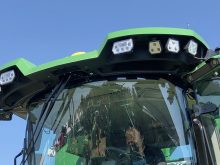ATLANTA, Ga. – The link between the tractor’s steering wheel and the ground has generally included a great physical relationship; but it’s over.
John Deere’s latest development in steering replaces that arrangement, which involved a steering box, a set of hydraulic valves or some other form of tied connection from tire to steering wheel.
Instead, the steering wheel becomes a sophisticated computer controller, managing a variable steering ratio and load to simulate physical steering wheel drag.
Steve Edwards of John Deere told engineers and farmers attending the American Society of Agricultural and Biotechnical Engineers at a meeting in Atlanta last month that new technology improves control.
Read Also

U.S. bill could keep out Canadian truckers
The Protecting America’s Roads Act, which was tabled in the U.S. House of Representatives at the beginning of October, would “rid the country of illegal immigrant commercial truck drivers and ineligible foreign nationals.”
“It’s called Active Command Steering, it is really a steer by wire,” he said of the technology that is often better associated with robotics or commercial aircraft and is now available as an option on the John Deere 8R series for 2011 and beyond.
“We saw it as something of a customer value issue, comfort and control in a variety of conditions, such as high speed transport, field and loader operations,” he said about the new steering system.
Using a combination of sensors and remote valves to control steering from an electronically managed steering wheel, the user gets feedback from the steering system via an electrically created magnetic load.
For years Deere built European tractors with lower ratio steering, when measured lock to lock. That gave operators fewer turns of the wheel to control their machines while performing road related tasks.
“They tend to do more over-the-road hauling with their tractors there,” he said.
The North American machines needed more mechanical advantage for turning under load in soft fields and finer control at low speed for fieldwork with large implements.
“Farm tractors tend to over-steer in the corners due to slow response (times) and high mass. We were able to overcome a lot of that, a big issue for farmers carrying loads like forage or manure,” he said.
Product manager Matt Arnold of John Deere said a gyroscope measures cab sway and tractor yaw to help manage the steering controller.
“And we got the size of the wheel down so that it doesn’t obscure as much of the view,” said Arnold of the magnetic particle break unit that will vary from 3.5 turns from lock to lock at high speed to 5.5 turns when in a low speed situation.
The new system reduces the movement that an operator’s hand typically makes from side to side while guiding a tractor forward by as much as 75 percent.
“That reduces fatigue in the field,” said Edwards.
The engineer said the design has multiple redundancies that prevent sudden failure and loss of control.
“There are two (electrical) channels running all the time, one from the alternator and one from the battery. All sensors are redundant. If there is a fault detected it reduces the machine to 10 km-h.”
He said if one of the machine’s steering or electrical systems were to fail, the tractor would allow for a slow ride home, but once it was parked and shut off it would prevent anyone from starting it and driving off without further servicing.
You’d be surprised how quickly people find the system comfortable.”
———
“access=subscriber section=production, none, none
















